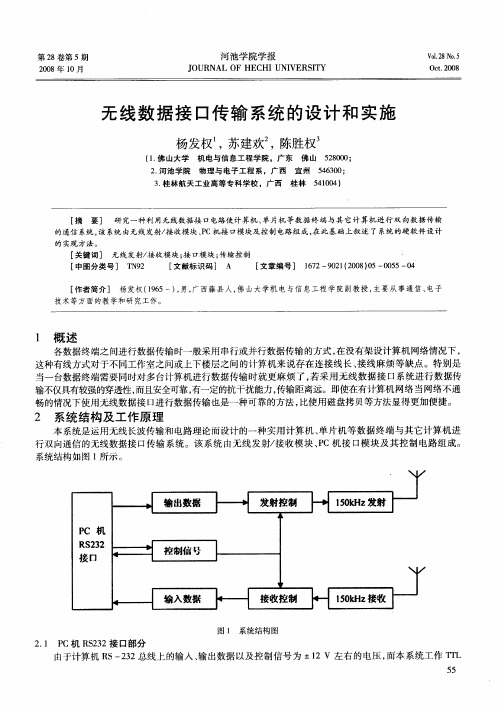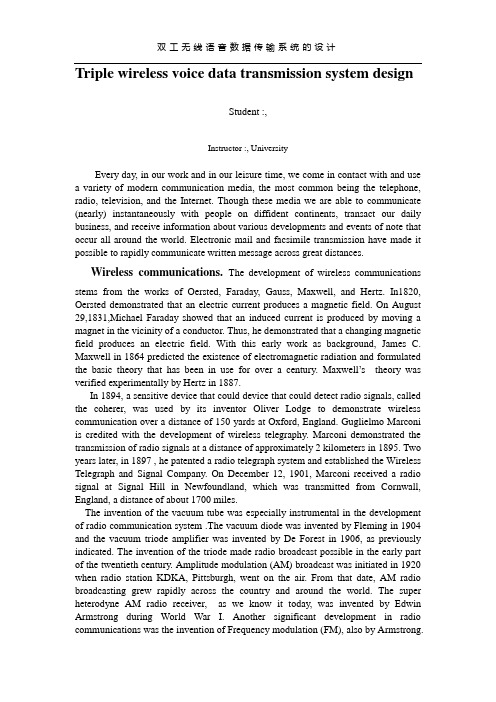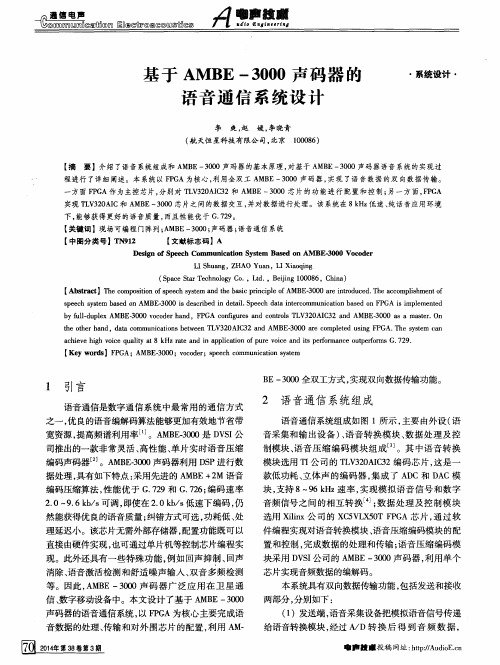双工无线语音数据传输系统的设计
- 格式:doc
- 大小:734.34 KB
- 文档页数:25


通信技术中的全双工通信的原理和实际应用全双工通信是一种在通信系统中允许数据同时进行双向传输的技术。
它允许发送方和接收方可以同时发送和接收信息,这样能够提高通信效率和传输速度。
本文将介绍全双工通信的原理和实际应用。
首先,让我们来了解全双工通信的原理。
全双工通信是通过使用两个独立的信道来实现的,一个用于发送数据,另一个用于接收数据。
这两个信道在物理上是分离的,因此可以同时进行数据的发送和接收。
通常,全双工通信中使用的信道可以是光纤、电缆、无线电波等。
实现全双工通信的一个重要组成部分是双工器。
双工器是一种用于在同一信道上实现双向通信的设备。
它可以分离发送和接收信号,使它们能够同时进行。
双工器可以将发送方的信号分离出来,然后将其传输到接收方,同时将接收方的信号分离出来,然后将其传输到发送方。
这样,发送方和接收方就可以在同一信道上同时进行通信。
全双工通信的实际应用非常广泛。
在电话系统中,全双工通信被广泛应用。
例如,当两个人进行电话对话时,每个人都可以同时说话和听对方说话,而不需要等待对方完成。
这样可以实现更加流畅和自然的对话。
另一个实际应用是在计算机网络中。
在局域网、广域网和互联网中,全双工通信被广泛用于数据的传输。
例如,在一个局域网中,当一个计算机发送数据给另一个计算机时,它可以同时接收来自另一个计算机的数据,而不需要等待。
这样可以提高数据传输的效率和速度。
此外,全双工通信还在无线通信中得到了广泛应用。
例如,在无线电对讲机中,全双工通信允许用户同时发送和接收语音信息。
这样可以实现快速和高效的信息交流。
总结一下,全双工通信是一种能够同时进行双向数据传输的通信技术。
它通过使用两个独立的信道和双工器来实现。
全双工通信的实际应用非常广泛,在电话系统、计算机网络和无线通信中都有所应用。
通过使用全双工通信,可以提高通信的效率和传输速度,实现更加流畅和高效的数据传输。

Triple wireless voice data transmission system designStudent :,Instructor :, UniversityEvery day, in our work and in our leisure time, we come in contact with and use a variety of modern communication media, the most common being the telephone, radio, television, and the Internet. Though these media we are able to communicate (nearly) instantaneously with people on diffident continents, transact our daily business, and receive information about various developments and events of note that occur all around the world. Electronic mail and facsimile transmission have made it possible to rapidly communicate written message across great distances.Wireless communications. The development of wireless communications stems from the works of Oersted, Faraday, Gauss, Maxwell, and Hertz. In1820, Oersted demonstrated that an electric current produces a magnetic field. On August 29,1831,Michael Faraday showed that an induced current is produced by moving a magnet in the vicinity of a conductor. Thus, he demonstrated that a changing magnetic field produces an electric field. With this early work as background, James C. Maxwell in 1864 predicted the existence of electromagnetic radiation and formulated the basic theory that has been in use for over a century. Maxwell’s theory was verified experimentally by Hertz in 1887.In 1894, a sensitive device that could device that could detect radio signals, called the coherer, was used by its inventor Oliver Lodge to demonstrate wireless communication over a distance of 150 yards at Oxford, England. Guglielmo Marconi is credited with the development of wireless telegraphy. Marconi demonstrated the transmission of radio signals at a distance of approximately 2 kilometers in 1895. Two years later, in 1897 , he patented a radio telegraph system and established the Wireless Telegraph and Signal Company. On December 12, 1901, Marconi received a radio signal at Signal Hill in Newfoundland, which was transmitted from Cornwall, England, a distance of about 1700 miles.The invention of the vacuum tube was especially instrumental in the development of radio communication system .The vacuum diode was invented by Fleming in 1904 and the vacuum triode amplifier was invented by De Forest in 1906, as previously indicated. The invention of the triode made radio broadcast possible in the early part of the twentieth century. Amplitude modulation (AM) broadcast was initiated in 1920 when radio station KDKA, Pittsburgh, went on the air. From that date, AM radio broadcasting grew rapidly across the country and around the world. The super heterodyne AM radio receiver, as we know it today, was invented by Edwin Armstrong during World War I. Another significant development in radio communications was the invention of Frequency modulation (FM), also by Armstrong.In 1933, Armstrong built and demonstrated the first FM communication system. However, the use of FM was slow to develop compared with AM broadcast. It was not until the end of World War II that FM broadcast gained in popularity and developed commercially.The first television system was built in the United States by V. K. Zworykin and demonstrated in 1929. Commercial television broadcasting began in London in 1936 by the British Broadcasting Corporation(BBC) . Five years later the Federal Communications Commission(FCC) authorized television broadcasting in the United States.ELEMENTS OF AN ELECTRICAL COMMUNICA SYSTEM Electrical communication systems are designed to send messages or information from a source that generates the message to one more destinations. In general, a communication system can be represented by the functional block diagram shown . The information generated by the source may be of the form of voice (speech source), a picture (image source), or plain text in some particular language, such as English , Japanese, German , French, etc. An essential feature of any source that generates information is that its output is described in probabilistic terms; i.e., the output of a source is not deterministic. Otherwise, there would be no need to transmit the message.A transducer is usually required to convert the output of a source into an electrical signal that is suitable for transmission. For example, a microphone serves as the transducer that converts an acoustic speech signal. At the destination, a similar transducer is required to convert the electrical signals that are received into a form that is suitable for the user; e.g., acoustic signals, images, etc.The heart of the communication system consists of three basic parts, namely, the transmitter, the channel, and the receiver. The functions performed by these three elements are described next.The Transmitter. The Transmitter converts the electrical signal into a form that is suitable for transmission though the physical channel or transmission medium. For example, in radio and TV broadcast, the Federal Communications Commission (FCC) specifies the frequency range for each transmitting station. Hence, the transmitter must translate the information signal to be transmitted into the appropriate The Transmitter range that matches the frequency allocation assigned to the transmitter. Thus, signal transmitted by multiple radio station do not interfere with one another. Similar functions are performed in telephone communication systems where the electrical speech signals from many users are transmitted over the same wire.In general, the transmitter performs the matching of the message signal to the channel by a process called modulation. Usually, modulation involves the use of the information signal to systematically vary either the amplitude, frequency, or phase of a sinusoidal carrier. For example, in AM radio broadcast, the information signal that is transmitted is contained in the amplitude variations of the sinusoidal carrier, which is the center frequency in the amplitude modulation. In FM radio broadcast., the information signal that is transmitted is contained in the frequency variations of thesinusoidal carrier. This is an example of frequency modulation. Phase modulation (PM) is yet a third method for impressing the information signal on a sinusoidal carrier.In general, carrier modulation such as AM, FM, and PM is performed at the transmitter, as indicated above, to convert the information signal to a form that matches the characteristics of the channel. Thus, though the process of modulation, the choice of the type of modulated in frequency to match the allocation of the channel. The choice of the type of modulation is based on several factors, such as the amount of bandwidth over the channel, the type of noise and the interference that the signal encounters in transmission. In any case, the modulation process makes it possible to accommodate the transmission of multiple messages from many users over the same physical channel.In addition to modulation, other functions that are usually performed at the transmitter are filtering of the information-bearing signal , amplification of the modulated signal, and in case of wireless transmission, radiation of the signal by means of a transmitting antenna.The channel. The communications channel is the physical medium that is used to send the signal from the transmitter to the receiver. In wireless transmission, the channel is usually the atmosphere (free space). On the other hand, telephone channels usually employ a variety of physical media, including wirelines, optical fiber cables, and wireless (microwave radio). Whatever the physical medium for signal transmission, the essential feature is that the transmitted signal is corrupted in a random manner by a variety of possible mechanisms. The most common from of signal degradation comes in the form of additive noise ,which is generated at the front end of the receiver, where signal amplification is performed. This noise is often called thermal noise. In wire less transmission, additional additive disturbances are man-made noise, and atmospheric noise picked up by a receiving antenna. Automovile ignition noise is an example of man-made noise, and electrical lightning discharges from thunderstorms is an example of atmospheric noise. Interference from other users of the channel is another form of additive noise that often arises in both wireless and wire line communication systems .In some radio communication channels, such as the ionospheric channel that is used for long range ,short-wave radio transmission, another form of signal degradation is multipath propagation. Such signal distortion is characterized as a nonadditive signal disturbance which manifests itself as time variations in the signal amplitude, usually called fading .Both additive and nonadditive signal distortions are usually characterized as random phenomena and described in statistical terms. The effect of these signal distortions must be taken into account on the design of the communication system.In the design of a communication system, the system, the system designer works with mathematical models that statistically characterize he signal distortion encountered on physical channels. Often, the statistical description that is used in mathematical model is a result of actual empirical measurements obtained from experiments involving signal transmission over such channels .In such cases , there isa physical justification for the mathematical model used in the design of communication systems. On the other hand, in some communication system designs ,the statistical characteristics of the channel may vary significantly with time. In such cases, the system design may designer may design a communication system that is robust to the variety of signal distortions. This can be accomplished by having the system adapt some of its parameters to the channel distortion encountered.The receiver. The function of the receiver is to recover the message signal contained in the received signal. If the message signal is transmitted by carrier modulation, the receiver performs carrier demodulation in order to extract the message from the sinusoidal carrier. Since the signal demodulation is performed in the presence of additive noise and possibly other signal distortion, the demodulated message signal is generally degraded to some extent by the presence of these distortions in the received signal. As we shall see, the fidelity of the additive noise, the type and strength of any other additive interference, and the type of any nonadditive interference.Besides performing the primary function of signal demodulation, the receiver also performs a number of peripheral functions, including signal filtering and noise suppression.Digital Communication SystemAn electrical communication system in rather broad terms based on the implicit assumption that message signal is a continuous timevarying waveform. We refer to such continuous-time signal waveforms as analog sources. Analog signal can be transmitted directly via modulation over the communication channel and demodulated accordingly at the receiver. We call such a i communication system an analog communication system.Alternatively, an analog source output may be converted into a digital form and the message can be transmitted via digital modulation as a digital signal at the receiver. There are some potential advantage to transmitting an analog signal by means of digital modulation. The most important reason is that signal fidelity is better controlled though digital transmission than analog transmission. In particular, digital transmission allows us to regenerate the digital signal in long-distance transmission, thus eliminating effects of noise at each regeneration point. In contrast, the noise added in analog transmission is amplified along with the signal when amplifiers are used periodically to boost the signal level in long-distance transmission. Another reason for choosing digital transmission over analog is that the analog message signal may be highly redundant. With digital processing, redundancy may be removed prior to modulation, thus conserving channel bandwidth. Yet a third reason may be that digital communication systems are often cheaper to implement.In some applications, the information to be transmitted is inherently digital; e.g., in the form of English text, computer data, etc. In such cases, the information source that generates the data is called a discrete (digital)source.In a digital communication systems , the some applications, the functional operations performed at the transmitter and receiver must be expanded to includemessage signal discrimination at the transmitter and message signal synthesis or interpolation at the receiver. Additional functions include redundancy removal, and channel coding and decoding.The source output may be either an analog signal, such as audio or video signal, or a digital signal , such as the output of a computer which is discrete in time and has a finite number of output characters. In a digital communication system, the message produced by the source are usually converted into a sequence of binary digits as possible. In other words, we seek inefficient representation of the source output of either an analog or a digital source into a sequence of binary digits is called source encoding or date compression.The sequence of binary digits from the coerce encoder, which we call the information sequence is passed to the channel encoder. The purpose of the channel encoder is to introduce, in a controlled manner, some redundancy in binary information sequence which can be used at the receiver to overcome the effects of noise and interference encountered in the transmission of the signal though the channel. Thus the added redundancy serves to increase the reliability of the received data and improves the fidelity in decoding the deceived signal. In fact, redundancy serves in the information sequence aids the receiver in decoding the desired information sequence .The binary sequence at the output of the channel encoder is passed to the digital modulator, which servers as the interface to the communications channel. Since nearly all of the communication channels encountered in practice are capable of transmitting electrical signals (waveforms), the primary purpose of the digital modulator is to map the binary information sequence into signal waveforms.At the receiving end of a digital communication system, the digital demodulator processes the channel-corrupted transmitted waveform and reduces reduce each waveform to a signal number that represents an estimate of the transmitted data symbol (binary or Mary) . When there is no redundancy in the transmitted information, the demodulator must decide which of the M waveform was transmitted in any given time interval. A measure of how well the demodulator and encoder perform is the frequency with which errors occur in the decoded sequence.As a final step, when an analog output is desired, the source decoder accepts the output sequence from the channel and , from knowledge of the source-encoding method used, attempts to reconstruct the original signal from the source.双工无线语音数据传输系统的设计学生:学院指导老师:汉大学在日常的工作和生活中,人们每天都要接触和使用大量的现代通信系统和通信媒介,其中最常见的是电话,无线电广播,电视和因特网。

单双工的原理及应用1. 什么是单工和双工单工(Simplex)和双工(Duplex)是指在通信系统中,信息传输的方向和方式。
在单工通信中,数据仅仅在一个方向上进行传输,而在双工通信中,数据可以同时在两个方向上进行传输。
2. 单工的原理和应用2.1 单工的原理单工通信是指数据在通信双方之间只能单向传输,无法进行双向传输。
在单工通信中,通信设备可以充当发送方或接收方,但不能同时充当两者。
在单工通信中,发送方将数据传输到接收方,但接收方无法给发送方发送回复。
这种通信方式适用于只需要一方向传输数据的场景。
2.2 单工的应用单工通信适用于一些场景,如:•电视广播:电视广播信号只能从电视台传输到用户的电视机上,用户不能通过电视机发送信号给电视台。
•AM/FM广播:传统广播接收器只能接收广播信号,无法发送信号。
•遥控器:遥控器只能向电视、空调等设备发送信号,无法接收信号。
3. 双工的原理和应用3.1 双工的原理双工通信是指数据可以在两个方向上同时进行传输。
在双工通信中,通信的双方既可以充当发送方,也可以充当接收方。
这种通信方式允许双方可以同时发送和接收数据。
在双工通信中,发送方和接收方通过共享的通信通道进行交互。
发送方将数据传输到通道中,接收方可以实时接收到发送方传输的数据,并且也可以将自己的数据传输到通道中。
3.2 双工的应用双工通信适用于一些场景,如:•电话通信:在电话通信中,双方可以同时进行通话,双方可以交替进行发言和听取对方的发言。
•对讲机:对讲机可以实现双方之间的实时语音交流,双方可以同时发送和接收语音消息。
•视频会议:在视频会议中,与会人员可以同时进行语音和视频交流。
4. 单工和双工的对比单工和双工具有以下几点区别:•数据传输方向:单工只能在一个方向上传输数据,而双工可以同时在两个方向上进行数据传输。
•通信能力:单工通信只有发送数据的能力,而双工通信具有双向传输数据的能力。
•通信效率:由于单工通信只能在一个方向上传输数据,所以比双工通信的传输效率低。

单工/双工无线呼叫系统SMART-PTT功能特点终端对讲,一机多用无线有线,通信一体无线手持智能终端具有集群对讲功能,并且可以收取航班动态,工作任务,汇报工作进展情况,语音通信和数据通信有机集成。
支持无线手持终端之间,电脑与无线手持终端,电脑与电脑之间的集群对讲和数据通信。
灵活群组,层次管理支持灵活、动态的群组配置,可以按照不同单位/部门、调度的级别、不同的岗位、不同工作性质配置集群对讲群组,实现层次管理(参见图1),也可以以某一个航班为中心,实时、动态地形成跨单位、跨部门的集群对讲群组,实现高效的协同服务对讲(参见图2)。
一按即说,无需拨号用户无论是使用无线手持智能终端,还是使用电脑,只需按一个键即可以向个人或群组发起通话,无需拨号和等待对方摘机。
永远在线,实时通信一旦登陆,永远在线,实时显示状态(在线,离线,忙碌,提示等),让沟通更自由。
多种方式,安全通话可以进行一对一和一对多的通信方式,拥有多重安全保护机制保证通信的私密性,通信不受任何打扰和防止窃听。
单工/双工无线呼叫系统SMART-PTT语音编码目前系统支持的语音编码为AMR NB,LPC,CELP.AMR NB的速率有:4750bps,5150bps,5900bps,6700bps,7400bps,7950bps,1020bps,1220bpsLPC的速率有:1800bps,2400bps,4000bps,5400bpsCELP速率:2400bps单工/双工无线呼叫系统SMART-PTT认证加密系统认证时采用SHA1 MAC算法对数据进行加密认证。
系统传输敏感数据时采用DES对数据进行加密,防止了传输明文。
管理系统采用MD5算法用户进行认证。

实验七图像语音全双工光纤综合传输系统实验
一、实验目的
1.学习并掌握计算机RS232通信技术。
2.掌握时分复用技术和波分复用技术的灵活搭配使用
二、实验内容
1.实现四台计算机和语音同时通信
三、实验仪器
1.光纤实验系统1 台
2.光纤跳线1 根
3.计算机若干台串口通信电缆若干根(数量根据计算机数量配置)
4.示波器1台
5.1310nm/1550nm波长波分复用器2个
四、实验原理
本实验主要实现了模拟图像、数据在同一光纤中传输。
在实际应用中,光纤有时用来传输数据,有时又用来传输模拟信号。
五、注意事项
1.在实验过程中切勿将光纤端面对着人,切勿带电进行光纤的连接。
六、实验步骤
1.实验框图如下,参考前面的实验自己设计连线方式并连接好。
2.打开系统电源。
调节光收发模块的状态,使计算机数据能够正常传输,图象能够正常传输。
计算机计
算
机
计
算
机
算机1
算
机
2算
机
3
七、实验总结
此实验学习了图像/语音全双工光纤综合传输系统实验,了解了基于计算机RS232的通信技术,经过本次实验深入的对光纤通信系统的传输进行了学习。
掌握了时分复用技术和波分复用技术的灵活搭配使用。
对图像语音全双工光纤综合传输系统有了基本的理解。
双工无线语音数据传输系统的设计摘要通信系统是用以完成信息传输过程的技术系统的总称。
现代通信系统主要借助电磁波在自由空间的传播或在导引媒体中的传输机理来实现,前者称为无线通信系统,后者称为有线通信系统。
当电磁波的波长达到光波范围时,这样的电信系统特称为光通信系统,其他电磁波范围的通信系统则称为电磁通信系统,简称为电信系统。
本文介绍一款采用D1800和D2822芯片设计的调频无线语音传输系统,D1800为收音集成电路,功放选用D2822,对讲的发射部分采用两级放大电路,第一级为振荡兼放大电路;第二级为发射部分,采用专用的发射管使发射效率和对讲距离大大提高。
它具有灵敏度高、对讲距离远、性能稳定、耗电省、输出功率大等特点,此款调频收音机对讲机克服了电路复杂、故障范围大、对讲距离近的矛盾,通过全新的设计使电路简化,性能大大提高.对讲距离迅速提高。
关键词:通信系统、调频无线语音传输系统、芯片D1800Triple wireless voice data transmission system design Student : Liu figure, physics and information engineering collegesInstructor : Xiao Y un hong, Jianghan UniversityAbstractCommunication system is used for the completion of the process of information transmission technique system of floorboard. Modern communication system mainly using electromagnetic wave in free space in the spread of guidance in the media or transmission mechanism to realize, the former called wireless communication system, the latter is called cable communication system. When the wavelength of the electromagnetic wave to light waves range, such telecommunications < /view/3923.htm > system, called optical communication system, other electromagnetic wave range of communication system is called electromagnetic communication system, referred to as "telecommunications system.This paper introduces a the D1800 add and D2822 chip design of FM radio interphone, D1800 radio for integrated circuit, amplifiers choose D2822, interphone launch of the two stage amplifier circuit, the first level for oscillation and amplifying circuit; The second part for launch, using special to launch the tube efficiency and the intercom distance is greatly increased. It has a high sensitivity, the intercom distance, stable performance, power saving, output power big features, this FM radio interphone overcome the circuit fault range, complex, the contradiction of the intercom closer, through the new design the circuit simplified, performance is greatly increased. The intercom distance rapidly increased.Key W ord:Communication system, FM radio, D1800 chip目录1 绪论 (4)1.1 通信系统发展 (4)1.2 通信系统的组成 (4)1.3 无线通信系统的类型 (5)1.4 无线通信系统前景 (5)2 设计内容及方案 (6)2.1设计目的 (6)2.2 设计思想 (6)2.3系统方案论证 (7)2.3.1 集成调频发射机芯片选择 (7)2.3.2调制部分方案比较 (8)2.3.3高频电路部分方案选择: (14)2.3.4 方案确定 (15)3 设计原理 (17)3.1 D1800简介 (17)3.2 高频功率放大器 (17)3.3 混频器原理 (18)3.3.1 混频器功能 (18)3.3.2混频器的工作原理 (19)3.3.3混频器的主要性能指标 (20)3.4 调频发射机 (21)3.5 调频接收机 (21)3.6 无线语音传输原理 (22)4 仿真与调试 (22)4.1 电路仿真 (22)4.2 实物制作 (22)4.3实物调试 (23)5 总结 (23)6 致谢 (24)参考文献 (25)1 绪论1.1 通信系统发展通信是在人类实践过程中随着社会生产力的发展对传递消息的要求不断提升使得人类文明不断进步。
在各种各样的通信方式中,利用“电”来传递消息的通信方法称为电信(Telecommunication),这种通信具有迅速、准确、可靠等特点,且几乎不受时间、地点、空间、距离的限制,因而得到了飞速发展和广泛应用;在现今因电波的快捷性使得从远古人类物质交换过程中就结合文化交流与实体经济不断积累进步的实物性通信(邮政通信)被人类理解为制约经济发展的阻碍。
在古代,人们通过驿站、飞鸽传书、烽火报警、符号、身体语言、眼神、触碰等方式进行信息传递。
到了今天,随着科学水平的飞速发展,相继出现了无线电、固定电话、移动电话、互联网甚至视频电话等各种通信方式。
通信技术拉近了人与人之间的距离,提高了经济的效率,深刻地改变了人类的生活方式和社会面。
通信的根本任务是远距离传输信息,准确地传输数字信息是数字通信中的一个重要环节。
包括调制与解调,如果把调制与解调过程看做是广义信道的一部分,则任何数字传输系统均可等效为基带传输系统。
理论上还可证明,任何一个采用线性调制的频带传输系统,总是可以由一个等效的基带传输系统来代替。
无线语音数据传输系统是一种工程性和实践性都很强的高频应用电子技术。
数据采集部分电路将语音话筒的电压模拟量采集,转换成数字量后,再又单片机进行数据计算压缩储存,其任务具体地说就是采集传感器输出的模拟信号并转换成计算机能识别的数字信号,然后送入计算机,根据不同的需要由计算机进行相应的计算和处理,得出所需的数据。
此电路要求具有灵敏度高,抗干扰能力强,工作可靠,组装容易,调试简便等特点。
能够满足实时采集、实时处理和实时控制等要求。
1.2 通信系统的组成无线通信的类型很多,可以根据传输方法、频率范围、用途等分类。
不同的无线通信系统,其设备组成和复杂度虽然有较大差异,但它们的基本组成不变。
一般由信源、信宿(收信者)、发端设备、收端设备和传输媒介等组成如图1-1所示。
图1-1 基本通信系统来自信源的消息(语言、文字、图像或数据)在发信端先由末端设备(如电话机、电传打字机、传真机或数据末端设备等)变换成电信号,然后经发端设备编码、调制、放大或发射后,把基带信号变换成适合在传输媒介中传输的形式;经传输媒介传输,在收信端经收端设备进行反变换恢复成消息提供给收信者。
这种点对点的通信大都是双向传输的。
因此,在通信对象所在的两端均备有发端和收端设备。
应当指出,实际的通信设备比理论的要复杂得多。
比如发射机的振荡器和接收机的本地振荡器就可以用更复杂的组件—频率合成器(FS)来代替,它可以产生大量所需频率的信号。
1.3 无线通信系统的类型无线通信系统的类型,可以根据不同的方法来划分。
按照无线通信系统中关键部分的不同特性,有以下一些类型:按照工作频段或传输手段分类,有中波通信、短波通信、超短波通信、微波通信和卫星通信等。
所谓工作频率,主要指发射与接收的射频频率。
射频实际上就是“高频”的广义语,它是指适合无线电发射和传播的频率。
无线通信的一个发展方向就是开辟更高的频段;按照通信方式来分类,主要有(全)双工、半双工和单工方式。
所谓单工信,指的是只能发或只能收的方式;半双工通信是一种既可以发也可以收但不能同时收发的通信方式;而双工通信是一种可以同时收发的通信方式;通信系统按通信业务(即所传输的信息种类)的不同可分为电话、电报、传真、数据通信系统等。
信号在时间上是连续变化的,称为模拟信号(如电话);在时间上离散、其幅度取值也是离散的信号称为数字信号(如电报)。
模拟信号通过模拟-数字变换(包括采样、量化和编码过程)也可变成数字信号。
通信系统中传输的基带信号为模拟信号时,这种系统称为模拟通信系统;传输的基带信号为数字信号的通信系统称为数字通信系统。
各种不同类型的通信系统,其系统组成和设备的复杂程度都有很大的不同。
但是组成设备的基本电路及其原理都是相同的,遵从同样的规则。
1.4 无线通信系统前景由于无线通信具有可移动性及真正三维物理空间的无缝隙覆盖能力;具有广域复杂网络拓扑的构成能力;具有良好的灵活性与普遍服务能力。
而且,实践已经证明,无线通信对抗震救灾等突发重大事件,其高度安全可靠、灵活机动体现了其卓越的应变能力;另外,其前期投资较少,以及卫星通信对区域及国际通信等长途通信距离均不敏感等等,这一系列优点,对未来信息社会的全球个人通信的无缝隙覆盖、多媒体运行而言,无线通信——尤其是地面移动通信和卫星通信,将扮演一种独具魅力的角色,而且会显得愈来愈重要。
近几年,中国的移动通信增长率一直在以超摩尔定律的速度发展着,而且,其市场预测前景依然十分诱人。
一些预测资料显示,到2000年,全球移动电话用户将达到4.5亿左右,其中亚太地区可能占三分之一左右,而中国又可能占亚太地区的三分之一左右。